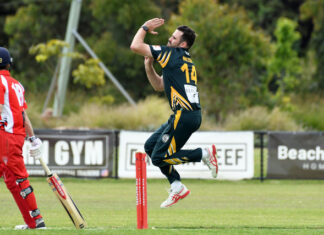 Inspecting the scanner were, from left, DPI research scientist Rebecca Bruce, GippsDairy executive officer Dr Danielle Auldist and senior research scientist Dr Kevin Powell. Quad-bike rider, Jon Medway,
Inspecting the scanner were, from left, DPI research scientist Rebecca Bruce, GippsDairy executive officer Dr Danielle Auldist and senior research scientist Dr Kevin Powell. Quad-bike rider, Jon Medway,SEARCH and destroy missions could help eradicate cockchafers before they wreak havoc on pastures and profitability.
Farmers are being asked to capture red headed cockchafer and post them off for a survey of the region’s infestations.
Red headed cockchafer infestation costs an average of $115,500 per annum for farmers who are the unwilling hosts of the tiny beetle. It costs the Victorian dairy industry many millions of dollars each year.
But a new scanning device fitted to a four-wheel motorbike could revolutionise the way landholders plan their attack on the highly-destructive insect.
A specifically designed remote sensing unit fitted onto the quad bike can detect changes in electrical conductivity in grasses.
Researchers believe these changes could indicate heavy infestations of red headed cockchafers in the soil.
The technology was recently trialed on dairy farms across Gippsland with the data being analysed in the new year.
GippsDairy executive officer Danielle Auldist said early detection of infestation would allow farmers to break the breeding and development cycle of the insect.
“If this trial is successful, it could allow farmers to identify where heavy infestations are occurring and then deal with the problem.”
With the difficulty in identifying different species of beetles, GippsDairy and the DPI are seeking grubs and adult cockchafers to help pinpoint where and when infestations are occurring.
Landholders are asked to dig up a small patch of soil where they believe a red headed cockchafer infestation has occurred.
If grubs or adult beetles are present in the soil sample, they should be dug out and placed in a plastic container with a mixture of 70 per cent methylated spirits and 30 per cent water for at least two days.
The liquid can then be drained and tissue paper packed around the specimen. Then it is ready to post to GippsDairy at PO Box 1059, Warragul 3820 with details of when and where the cockchafers were collected. Details of the survey are available at www.gippsdairy .com.au or call 5624 3900.





